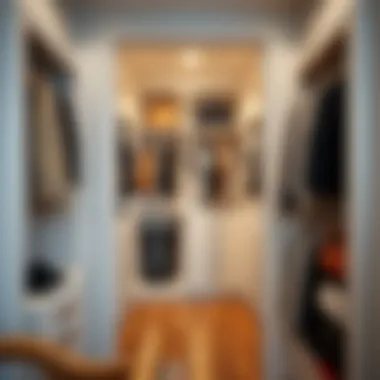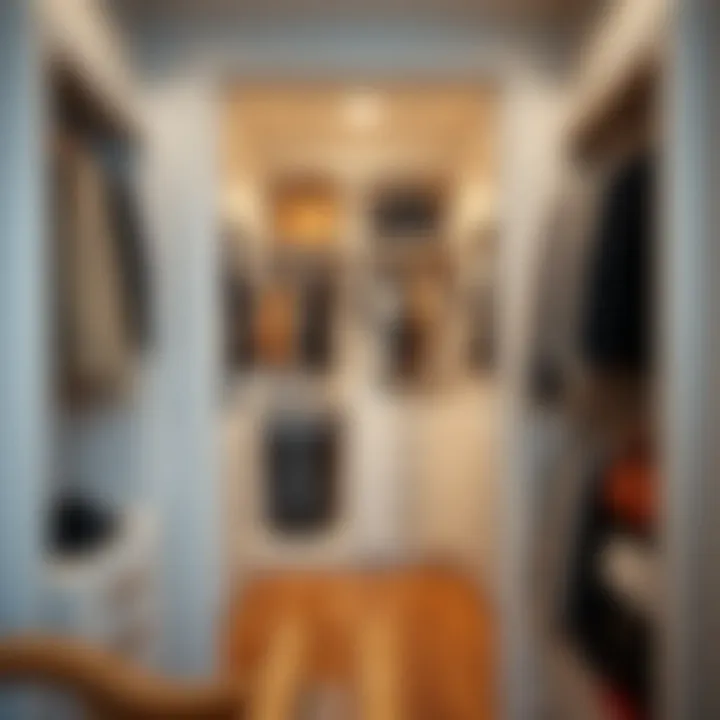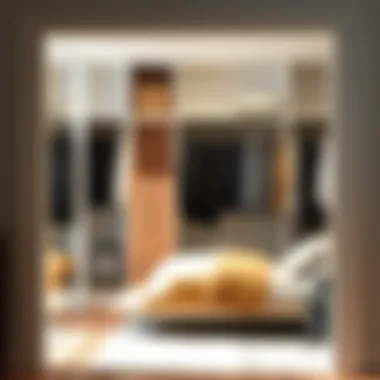Build a Stylish and Functional Walk-In Closet Organizer


Intro
Crafting an efficient walk-in closet organizer presents more than just a blend of aesthetics and functionality; it's about maximizing the space available while catering to individual tastes and needs. A well-planned closet can seamlessly integrate personal style with organizational systems that simplify daily routines. From disorganized chaos to a tailored haven for garments and accessories, the journey of constructing a walk-in closet organizer involves thoughtful design choices, mindful material selection, and a dash of creativity.
This article aims to guide readers through the important aspects of building a personalized closet that works for them—whether it’s to showcase an extravagant shoe collection or store everyday wear efficiently. The goal is to delve into design trends, practical solutions for space optimization, and ergonomic furniture choices that elevate the closet experience. With a clear roadmap, anyone can transform an ordinary walk-in closet into a remarkable personal space.
Understanding the Essentials of a Walk-In Closet Organizer
When tackling the task of organizing a walk-in closet, it’s imperative to grasp the fundamental aspects that contribute to an effective and efficient design. This section lays the groundwork for understanding how to transform a chaotic space into a well-structured haven for your clothing and accessories.
Defining Your Closet Space
To begin with, defining your closet space is a crucial step in this entire process. Before diving into the nitty-gritty of shelves and rods, it’s essential to take a good, hard look at what you’re working with. Measure your space thoroughly, keeping in mind the dimensions of the walls, the height of the ceiling, and the layout of windows and doors. This information not only informs your design but helps visualize how everything will fit together.
Think about how the current space functions for your needs. Are certain areas too cramped while others are underutilized? The goal is to maximize the usability without compromising on style.
Additionally, make a list of all existing items in the closet, as this will aid in determining the storage solutions required. Consider your clothes, shoes, bags, and even seasonal items. Understanding your inventory paves the way for a tailored setup that speaks to your personal requirements.
Recognizing the Need for Organization
The next essential aspect is recognizing the need for organization within your closet. You might question, “Why is organization so vital?” Well, simply put, an organized closet is an invitation to efficiency. It’s surprising how having a clean, well-ordered space can transform daily routines.
Think about the time wasted rummaging through piles of clothes to find that one shirt or jacket for an impromptu gathering. Imagine instead opening your well-structured closet and instantly spotting what you need. Not only does this make dressing a breeze, but it also enhances the preservation of your garments by preventing unnecessary wear and tear from constant handling.
Moreover, a tidy closet contributes to mental clarity. Clutter creates chaos, and chaos can be overwhelming. By implementing an efficient organizing system, you’re not just creating a beautiful space; you’re fostering a soothing atmosphere that resonates with calmness. Not to mention, it’s a great way to showcase your personal style while ensuring everything has its designated space.
In summary, understanding the essentials of a walk-in closet organizer involves defining your available space and recognizing the paramount need for organization. This clarity sets the stage for planning and design, ensuring your final walk-in closet is not just functional but also a reflection of who you are.
Planning Your Walk-In Closet Organizer
When it comes to revamping or creating a walk-in closet, the planning stage is of critical importance. You might think, "How hard can it be to throw some shelves in here?" But let me tell you, that mindset could lead to organizational chaos. A well-thought-out plan sets the foundation for maximizing both space and function.
Assessing Storage Requirements
Let’s break it down – assessing storage requirements involves looking at what you actually own, and perhaps where you can lighten the load. It’s a bitlike running an inventory, but not the boring kind; more of a ‘let’s face facts’ type deal. Consider these aspects:
- Clothing Types: Are you more of a formalwear fanatic or a laidback casual dresser? Knowing the variety will help determine how much hanging space versus shelf space you need.
- Accessories and Shoes: Do you have a penchant for shoes that would make a boutique green with envy? If you’re a shoe lover, prioritize vertical space and include shelves or cubbies that highlight your collection.
- Additional Items: Consider items that may not be clothing but still need storage—think bags, hats, or even seasonal gear. Drawing a list can prevent surprises down the line.
Here’s a tip: create a mock-up! You don’t need a fancy app; a simple sketch will do. Use this to visualize how much space each item type consumes. The clearer your vision, the easier it will be to create a closet that works like a charm.
Establishing a Functional Layout
The layout can often be the make-or-break aspect of walk-in closet design. Think of it as the architectural spine. To squeeze the most out of your space and ensure that it flows well, consider these factors:
- Zones: Organize your closet into zones—for example, a section for everyday wear, formal attire, and accessories. This way, you won’t find yourself fumbling through everything for that favorite dress.
- Accessibility: Position items according to how often you use them. For instance, keep daily wear within easy reach and seasonal items a bit further back. You want everything to be convenient without having to play hide-and-seek each time.
- Traffic Flow: Walk around in your closet schematic. If it feels cramped or you’re dodging corners, reevaluate your configurations. A well-placed mirror can also improve the sense of space and double as an essential grooming tool.
"Where there's a will, there's a way," right? Adequate planning and functional layout can turn a cluttered chaos into an efficient sanctuary. With a focus on personal habits and practical use throughout your day, you’ll create a space that not only looks good but feels good every time you step inside.
For further reading on effective space management, check out resources from universities like Harvard's design guidelines or visit tutorials on organizing principles at Reddit's r/HomeImprovement.
Ultimately, a little extra planning can yield a closet that shines just as brightly as the garments it houses.
Design Considerations for the Organizer
Design considerations play a pivotal role in the success of a walk-in closet organizer. This is not merely about placing some shelves and rods in a space; it’s about creating a coherent system that meets your specific needs while being aesthetically pleasing. Thoughtful design helps to maximize the usefulness of the space, enabling a smoother daily routine. Moreover, it gives you the chance to express your personal style, turning a functional area into a feather in your home's cap. Careful planning in these areas is essential for developing an effective organization system.
Balancing Aesthetics and Functionality
When thinking about a walk-in closet, the relationship between aesthetics and functionality becomes paramount. Picture a spacious closet where beauty meets utility—a space that does not just house your belongings but enhances your living environment. Choosing materials and colors that complement your home’s decor can significantly impact the visual appeal.
For instance, using soft neutrals can create a calm and soothing atmosphere, while brighter hues may energize the area. Additionally, integrating stylish cabinetry with classic hardware can bridge the gap between a chic look and practical use. Ultimately, a well-designed closet should not just serve a purpose, it should also feel inviting. A perfect blend of elegance and practicality is crucial.


Choosing a Design Style
Design style can vary widely, impacted by personal tastes and existing interior themes. You might lean towards a minimalist modern aesthetic, with sleek lines and open spaces, or perhaps you’re a fan of classic design, favoring ornate details and rich woods. Regardless of your preference, aligning your closet design with your overall home style is important for cohesion.
Some popular styles include:
- Modern: Think clean lines and open shelving for a fresh feel.
- Traditional: Features classic wood finishes and thoughtful trim for a timeless look.
- Industrial: Integrates metal pipes and rustic finishes for a unique edge.
- Farmhouse: Combines practicality with cozy charm through reclaimed wood and vintage elements.
Selecting the right style not only fulfills aesthetic goals but can also influence how you organize your items. For example, a farmhouse style might favor open shelving that encourages display, while a modern style may prioritize hidden storage.
Incorporating Lighting Solutions
Lighting is often an afterthought in closet design but can dramatically elevate the space. Good lighting can expose hidden corners, making access simpler and enhancing visibility. Incorporating LED strips along shelves or installing overhead lighting can illuminate the entire area and reduce the frustration of fumbling about in the dark. Natural lighting, if possible, can further enhance the experience—large mirrors can amplify light and create the illusion of more space while also serving a functional use.
There are a few effective lighting options to consider:
- Overhead fixtures: Provide general illumination for the entire closet.
- Task lighting: Useful over specific work areas, like benches or folding spaces.
- Accent lighting: Highlights special items or areas, lending a decorative touch.
Ultimately, a well-thought-out lighting design not only aids in functionality but can transform the closet into a welcoming, engaging space. Remember to assess the power source and wiring needs before you start installing lighting to ensure a hassle-free process.
Selecting the Right Materials
When embarking on the journey of creating a walk-in closet organizer, the materials you select play a crucial role not only in the durability and aesthetic appeal of the design but also in how effectively it meets your organizational needs. Choosing the right materials can dramatically enhance the functionality of the space, ensuring that it withstands daily use while also adding to the visual allure of your home. This section dives deep into the factors to consider while selecting materials, addressing both durability and aesthetics, as well as eco-friendliness which has become a significant point of interest in today’s design ethos.
Evaluating Durability and Appearance
Durability is paramount when evaluating materials for your closet organizer. After all, you want something that can handle heavy garments, shoes, and accessories without sagging or breaking down over time. Solid wood, for instance, is often preferred for its strength and aesthetic charm. It can take a beating and still look stunning, but it also comes at a price. Alternatives like MDF (Medium Density Fiberboard) can be more cost-effective while still providing a decent level of durability for shelves. No one wants to replace organizers every few years due to wear and tear, so opting for materials that can stand the test of time is key.
The appearance of materials is equally significant. Your walk-in closet is a reflection of your personal style. Do you lean towards a rustic look or is a sleek, modern aesthetic more your cup of tea? The finish of your materials can greatly influence the overall vibe; a matte finish may invoke warmth and coziness, while a glossy surface can create a sense of sophistication and sleekness. A good approach is to look at swatches and consider how different materials will look amidst the overall color scheme of your space.
In contrast, some might argue that practicality should trump aesthetics. However, it’s possible to strike a balance. A well-chosen material should not only look good but also perform its function efficiently. Whether you decide on stylish wire baskets or elegant wooden drawers, consider the harmony of utility and design.
"Quality materials can elevate a simple closet organizer to a stylish statement in your home."
Sourcing Eco-Friendly Options
In recent years, the call for eco-friendly options in home design has grown louder, and this trend rings true for closet organizers. Choosing sustainable materials isn’t just beneficial for the environment; it often means selecting items that are non-toxic and better for your personal health.
Bamboo is emerging as a popular choice due to its rapid growth and renewability. It boasts an attractive look while being strong and lightweight. Similarly, recycled materials—whether they’re metals or wood—are excellent options that minimize waste and add unique character to your closet.
When sourcing materials, check if suppliers are providing certifications that indicate eco-friendliness. For instance, look for products certified by organizations like the Forest Stewardship Council (FSC) which ensures responsible forest management.
Finally, don't forget about local materials. Using locally sourced materials not only supports local businesses but can also reduce the carbon footprint associated with shipping. It’s not uncommon to find stunning, locally-sourced materials that can add a unique touch to your walk-in closet.
In summary, selecting the right materials is a multifaceted task that requires a balance of durability, aesthetics, and sustainability. Taking the time to carefully plan will result in a closet organizer that stands the tests of time, reflects your style, and aligns with an environmentally-friendly ethos.
Tools and Equipment for Assembly
Building an efficient walk-in closet organizer is no small feat. It’s akin to piecing together a jigsaw puzzle but with more heft and complexity in materials and tools. Having the right tools and equipment is paramount to not only prevent headaches during assembly but also to secure results that stand the test of time. A well-planned assembly process saves time and effort in the long run, transforming mere materials into a usable and aesthetically pleasing storage solution.
When strategizing the assembly of your walk-in closet organizer, consider the following key elements:
- Precision and Accuracy: With proper tools, achieving clean cuts and straight lines becomes much easier, which minimizes the chance of errors.
- Safety: Using appropriate equipment significantly reduces the risk of injury.
- Efficiency: The right tools encourage a smoother workflow, limiting unnecessary frustration.
In short, investing time in acquiring the necessary tools will yield dividends in assembly quality.
Necessary Tools for a Smooth Construction
Getting down to brass tacks, having a toolbox loaded with the essentials makes all the difference. Below is a rundown of tools that will assist you:
- Measuring Tape: Fundamental for accurately measuring your closet space and cutting materials to size. A good measuring tape with clear markings is indispensable.
- Level: This tool ensures that your shelves and rods are perfectly horizontal, preventing slippage or tilting that could lead to potential collapse.
- Power Drill: Think of this as your best friend. It will help speed up the process of assembling materials such as fixing screws or drilling holes necessary for shelves and rods.
- Screwdriver Set: Both Phillips and flathead screwdrivers are crucial for various fastening needs. Ensure you have a good set, as losing time hunting for the right size can be a pain.
- Circular Saw or Jigsaw: If you’re working with wood or plywood, these saws come in handy for cutting down larger sheets into manageable sizes.
- Stud Finder: A must-have for securely mounting shelves and heavy-duty accessories onto walls. It helps you locate the wooden supports behind your drywall.
- Safety Glasses and Gloves: Safety is non-negotiable. Protect your eyes from debris and your hands from sharp edges or splinters.


These tools might look like common items, but together they are your toolkit for success. With them, you’ll not just be assembling; you’ll be constructing with confidence.
Safety Precautions During Assembly
Even the most seasoned DIYers can run into trouble. Hence, it’s wise to keep safety at the forefront during your build. Here are several precautions to keep in mind:
- Clear Work Area: Before starting, ensure that your workspace is organized. A clutter-free environment reduces the risk of trips and falls.
- Read Instructions Thoroughly: This can't be emphasized enough! Whether you’re following a plan or your own design, clear comprehension of the steps is crucial.
- Use Proper Lifting Techniques: When handling heavy materials, lift with your legs, not your back. It sounds simple, but doing this can prevent injuries.
- Avoid Distractions: Engage in your build when you can focus entirely on the task. Avoid multitasking, as distractions can lead to accidents.
- Keep Tools in Good Condition: Regular maintenance on your tools is non-negotiable. A dull saw or a corroded drill can break unexpectedly.
"An ounce of prevention is worth a pound of cure."
Practice these safety measures to keep your assembly process smooth and problem-free. Taking the time upfront to prioritize safety will contribute to the overall success of building your walk-in closet organizer.
Building the Framework
Building the framework of your walk-in closet organizer is akin to laying the cornerstone of a grand structure. This stage is vital—without a solid framework, the entire organizer risks becoming precarious or ineffective. Understanding the layout and systematically focusing on base elements and shelving provides both functionality and aesthetic appeal. Plus, a well-constructed framework sets the groundwork for all the accessories and features that will follow.
Constructing the Base and Shelving
Creating a sturdy base is where the magic begins. The base provides support for a variety of organizational features, whether they are shelves, drawers, or hanging rods. When selecting materials for your base, consider durability as well as weight capacity. Plywood can often be a wise choice due to its strength, and it is lighter than solid wood, making it easier to work with during assembly. Remember, if the base isn’t strong enough, it might bow under the weight of your carefully curated footwear collection.
For the shelving, think strategically about height and depth. An efficient shelving system won’t just be a flat board against a wall; it will have varying levels to cater to your different storage needs.
- Low shelves can be great for shoes or baskets that store small items, keeping everything within reach.
- Mid-height shelving works well for folded clothes or boxes, while higher shelves are ideal for those rarely-used items, like fancy dresses or seasonal decor.
Moreover, shelves should be adjustable if possible. This feature allows flexibility as your storage needs shift over time; children's clothing might get replaced by adult-sized items, or sports equipment could give way to hobby supplies.
Installing Closet Rods and Accessories
Once the base and shelving are in place, it is time to bring your vision to life through the addition of closet rods and accessories. Closet rods should be installed at a height that fits your style and storage needs. For long dresses and coats, ensure that you allow sufficient space; typically, 66 to 72 inches from the floor works well. On the other hand, for shirts, a height of about 40 to 42 inches is standard.
When installing rods, angle brackets or decorative ends can greatly enhance the overall aesthetic, adding an element of style and function. The choice between a single or double rod configuration often depends on the types of clothes you own. Using two rods allows for maximized vertical space, pairing short items like shirts above longer garments such as skirts.
Finally, consider accessories that enhance organization: baskets, hooks, and even specialized hangers. For instance, a series of hooks can hold bags or accessories that tend to get tossed aside. Baskets add a neatness factor, creating visual order while being practical for smaller items that can otherwise clutter your space.
An emphasis on these elements not only solidifies the function of your closet but also vastly improves the overall user experience. Remember, a well-constructed framework is more than just practicality; it unifies the whole closet, creating an environment where organization thrives.
Organizational Features to Include
Creating a walk-in closet organizer isn't just about putting up shelves and rods; it's about crafting a tailored system that meets your specific needs and maximizes your available space. This section dives into the organizational features that can elevate a basic closet into a well-oiled organization machine. Understanding these elements ensures that every item has its rightful place, contributing to a clearer mind and easier lifestyle.
Integrating Drawers and Bins
When it comes to walk-in closet organization, drawers and bins are your trusty allies. They offer an out-of-sight, out-of-mind approach to storage, letting you hide away personal items while keeping them accessible at a moment's notice. Consider this: personal garments or accessories can clutter surfaces but stashing them in a drawer makes the space feel instantly tidied up.
- Customization: Drawers come in various shapes and sizes. Choosing pull-out drawers for your accessories or bins for seasonal clothing allows you to customize the space, making your closet not just functional but asthetically pleasing, too.
- Efficient Use of Space: Installing drawers that pull out easily can double as working surfaces when laid out properly. A small, smooth surface can become prime real estate for folding clothes or displaying your latest purchases until you're ready to find a place for them.
- Labeling: A key component of organization is knowing where everything is. Consider clear bins or labeled drawers to make locating items a breeze. This simple step can save time on busy mornings and reduce the stress of searching for that elusive pair of shoes or accessory.
Integrating drawers and bins delivers the dual benefit of keeping clutter at bay while maintaining easy access to essentials. It's like having a little secret hideaway in your closet!
Positioning Hooks and Racks
Hooks and racks turn an ordinary closet into a functional space, allowing you to hang items that would otherwise clutter surfaces. These features offer flexibility in storage and accessibility that brings a breath of fresh air into your closet routine.
- Versatile Hanging: Think about the versatility of hooks. They can store bags, hats, and scarves, which otherwise take up precious drawer space or lay in piles. Imagine the ease of just grabbing a bag off the rack on your way out the door. It’s convenience at its finest!
- Adjustable Racks: Choosing racks that can be adjusted in height and spacing allows homeowners to change their organization system as their needs evolve. As seasons change, so too can your setup.
- Aesthetic Appeal: Hooks add not only functionality but also a touch of style. Decorative hooks can become part of the decor, transforming functional pieces into statements. Pairing style with efficiency is what modern organization is all about.
"A well-organized closet reveals the character of the buyer—style coupled with ogranization makes a powerhouse display of intentions."
Including these organizational features—drawers, bins, hooks, and racks—can fundamentally change the dynamics of your walk-in closet. By thoughtfully integrating these elements, you create a space that not only looks good but works even better, making your life a little bit easier one organized section at a time.
Maximizing Space Efficiency
Maximizing space efficiency is pivotal when crafting a walk-in closet organizer. As closet spaces can vary from generous to snug, utilizing every inch becomes essential not just for storage purposes, but also for maintaining a visually appealing and accessible environment. An efficient closet setup allows individuals to easily locate items, enhancing their daily routines and minimizing clutter. Improved organization leads to time savings and reduces unnecessary stress, resulting in a smoother start to anyone's day.


Utilizing Vertical Storage Solutions
The vertical space in a closet is often overlooked, yet it holds great potential for optimizing your storage. Making good use of the vertical dimension can transform a chaotic closet into a neatly arranged sanctuary.
One practical approach is to install tall shelving units that reach up to the ceiling. By doing this, you can store infrequently used items on the upper shelves while maintaining readily accessible items at eye level. For instance, seasonal clothing like winter coats or bulky bags can occupy the top shelves, keeping them out of the way yet still within reach when needed.
"When you think vertically, you gain a newfound freedom in your closet. Adding space, reducing clutter, and enhancing accessibility all at once."
Consider incorporating hanging organizers or pegboards that utilize wall space. These can effectively house accessories like ties, belts, or scarves, freeing up drawer space and keeping everything visible. Not to mention, this allows for easy customization as the needs evolve over time. Incorporating a ladder system, if space permits, can also allow for access to higher shelves while adding a touch of style.
A great tip is to select containers or boxes that are stackable, as they can maximize vertical space. This method keeps smaller items contained while ensuring everything can be retrieved easily without having to shuffle through multiple bins.
Employing Multi-functional Furniture
Multi-functional furniture serves as a smart solution for maximizing space efficiency in a walk-in closet. Investing in pieces that serve more than one purpose can dramatically improve both storage capability and the overall aesthetics of the closet.
For example, a bench that features built-in storage is a seamless addition. It provides a place to sit while dressing or putting on shoes, all the while offering extra storage for items like bags or shoes underneath. This dual function helps keep the floor area open, making the closet feel less cramped while still performing its essential duties.
Another alternative is utilizing ottomans with storage compartments. They can be used as seating during outfit selections while discreetly harboring rolled-up sweaters or accessories.
Consider the use of hangers that serve as organizers as well. Special hangers can fit multiple items, like skirts or scarves, displaying everything neatly without taking much space.
In essence, finding furniture that meshes well with your daily habits can help you manage the space better. This is particularly crucial for individuals with smaller walk-in closets where every square inch counts.
With these strategies, your walk-in closet can transition from a simple storage area to a personalized space that seamlessly blends efficiency and convenience. The investment in both vertical solutions and multi-functional furnishings not only optimizes the space but also enhances the everyday experience of utilizing the closet.
Maintenance of the Closet Organizer
When it comes to a walk-in closet organizer, maintenance plays a crucial role in ensuring that it remains functional and aesthetically pleasing over time. An efficient closet organizer is not merely a static structure; it’s a dynamic part of your daily routine that requires regular attention. By prioritizing maintenance, you not only prolong its lifespan but also enhance your overall user experience, allowing for easier access to your belongings and better organization.
Regular Cleaning and Upkeep
Regular cleaning isn’t just about picking up a duster—it involves developing a routine that keeps the closet fresh and organized. The dust and debris that accumulate can tarnish even the most beautiful of organizers. Tools such as a microfiber cloth and a vacuum can go a long way in maintaining a clean space.
- Start by decluttering: Go through your items every few months. Toss what you don't need or donate things that are still in good shape. This not only clears up space but also makes it easier to find what you're looking for.
- Dust surfaces regularly: Use a cloth to wipe down shelves and rods. Pay attention to hidden corners where grime likes to settle.
- Clean compartments: For drawers and bins, give them a good wash every now and then. It’s amazing how quickly they can accumulate crumbs or residue from various items.
In addition, keeping your closet organized can reduce stress. When everything is clean and in its place, you won't waste precious time looking for that perfect outfit before heading out.
"A cluttered closet is a cluttered mind. Keep it organized to find peace during daily routines."
Adjusting for Changing Needs
Life is ever-changing, and so are our storage needs. As time goes by, your collection of clothes, accessories, or other items may fluctuate. Hence, your walk-in closet organizer should be adaptable.
- Reassess usage: Every season, take stock of what you use regularly and what you don't. Are there clothes you haven’t worn in months? Consider reusing that space for seasonal clothing or different interests.
- Modify layouts: If you find yourself expanding your shoe collection or needing more storage for bags, consider reshuffling your organizer. Sometimes, just moving a shelf or adjusting the height of rods can create a world of difference.
- Incorporate new storage solutions: As trends come and go, you may find new organizers or modular systems that fit more naturally into your lifestyle. If you have kids, their needs will differ as they grow, and your closet should be equipped to change along with them.
By being proactive with maintenance and adjustments, you ensure that your walk-in closet continues to serve you well. Being organized isn't just about having a clean closet; it reflects a lifestyle choice that adds value to your day-to-day living. For further guidelines, check resources such as the National Association of Professional Organizers for practical tips that suit your needs.
Evaluating the Completed Organizer
Once you've put in the effort to construct your walk-in closet organizer, it’s time to take a step back, give it the once-over, and assess whether it truly delivers on its promises. Evaluating the completed organizer is not just a cursory glance—it's a vital process that ensures your hard work translates into practical functionality and meets all your expectations.
Assessing Functionality and Usability
Evaluating functionality revolves around one core question: Does it work? This means checking to see if everything is easily accessible, whether you can find what you need without turning your closet into a chaotic jumble. Think of it like test-driving a car after you've reworked its engine; you need to know if it drives smoothly or stalls at every corner.
- Accessibility: Open and close those drawers, swing that closet rod, and see if it flows. If you’re struggling to reach for your favorite pair of shoes because they are way at the back, you should reconsider placement or the layout itself.
- Storage Efficiency: Analyze how well space is utilized. Are you maximizing vertical storage by utilizing every inch from floor to ceiling, or is there wasted potential? Sometimes, a couple of extra shelves can be a game changer.
- User Interaction: Put yourself in your shoes—literally. Spend some time using the closet as you normally would. Is it intuitive to navigate? After a few uses, you should easily fall into a rhythm rather than feeling like you’re in a treasure hunt every morning.
Gathering Feedback for Improvements
No matter how well you think the process went, feedback is the name of the game. There’s a particular adage that rings true in many designs: "You don’t know what you don’t know." Sometimes, having fresh eyes can lead to a revelation.
- Get Opinions from Family: If the closet is for the whole family, gather insights from other users. They might have different preferences and needs that you haven't considered. Ask straightforward questions like, "Is there anything that feels awkward or inconvenient?" Don't hesitate to encourage honest feedback.
- Observe Usage Over Time: If you can, keep an eye on how the closet is used in the weeks following its completion. Notice what things get misplaced often or if there’s any consistent inconvenience. This long-term evaluation could reveal design flaws you overlooked
- Be Open to Adjustments: Based on the feedback, remain flexible to modify the organization. Maybe swapping positions of certain items can optimize flow, or adding more hooks for jackets might alleviate clutter.
Taking feedback and making improvements can be an ongoing journey rather than a one-time effort. It’s about fine-tuning a space that evolves along with your needs.
Evaluating your completed organizer lays the groundwork for a functional and visually appealing closet that suits your lifestyle. Remember that a well-thought-out space will save you time and turn your daily routine into a smoother operation.















